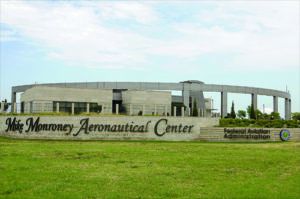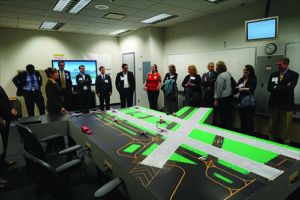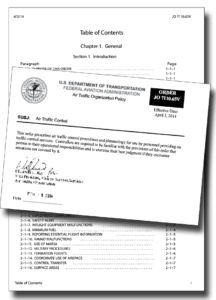
My present career as an air traffic controller started in 2008, when I took my first tower tour. I had earned my private pilot certificate earlier that year and wanted to meet the faces behind the voices I kept hearing. The two gentlemen I met had lengthy careers in the FAA, which included Flight Service and Air Traffic Control. They were immensely helpful with the questions I had. They had opposite personalities, yet sounded remarkably similar; I will never forget those guys.
Later in 2008, I graduated college, with a Bachelor of Science degree in Business Administration. It was not the best of times: I had debt, I had dreams and I needed a career. Early in 2009, after applying for numerous jobs, I landed a teaching position at the local high school. Apparently, my luck was changing because I discovered the FAA was accepting controller applicants “off the street.” I applied and about three months later, I was invited to take the FAA’s aptitude test.
FIRST TEST OF MANY
To give the aptitude test some perspective, it examined you for vocabulary, math and visual scanning, and included a simulation like the 1990s game Tetris, plus a radar simulation. It was slated as an eight-hour test; however, in my group of 20, the average completion time was approximately six hours.
Within two months, I was notified of my score and placed in the well-qualified category. The application allowed picking two different states you were willing to work in. I chose my home state of California, plus Texas. At the time the selection process began, there were no openings and I had to wait for another selection panel to convene. By this point, I knew I didn’t want to teach high school and really wanted to become a controller. I needed a faster track to get to my goal, a career with the FAA.
Some additional research led me to a school near me, Mt. San Antonio College, in Walnut, Calif. This school has a college training initiative (CTI) program recognized by the FAA for the Air Traffic Control Program. In late 2009, I enrolled at Mt. SAC in their aviation science program. Since I already had a bachelor’s degree, I was able to bypass the general education requirements and focus on taking only the necessary courses to complete the associate of science degree. By being a pilot in the program, you are also able to test out of certain courses. This helped me along in allowing me to complete all this within two semesters.
Once the program was completed, I was “grandfathered” and did not have to take the FAA test again since my score did not expire. I was then placed in the well-qualified group through the Mt. SAC program.
HURRY UP AND WAIT

In roughly three-month increments, I underwent additional testing, to include a second class FAA medical certificate, psychological exam and a background check with security clearance paperwork. The medical examination I received was the same as pilots take, except the hearing portion was done in greater detail. The psych exam was 500 questions, diving deep to figure out if you have substance dependency, depression, anger, anxiety or any other type of psychological issues that would need to be addressed.
The background check was intense. You must write down everything about yourself and the information put down will be verified. If there is something questionable in your background, you will either do a phone interview or talk to an investigator face-to-face. Either way, they are looking for honest candidates who recognize their mistakes in life and find themselves wanting to do better. Your credit and debt will be checked but if you can provide honest answers about your situation, you should be fine. All was good, so I waited to hear back from Human Resources. And waited.
About four years later, I heard from a friendly woman from the FAA’s Human Resources Department. She offered a terminal position, which I gladly took. The other alternative was an en route option, at the air route traffic control centers (ARTCCs). At the time, I was thankful because center training had just over a 50-percent failure rate. My initial facility assignment was in Northern California, at the Monterey Regional Airport.
About this time, the woman handling my file lost her position due to the sequester and a new person began handling my academy date. Six months later, I was reassigned to a tower facility in Southern California, the San Diego area. I took the next available academy date, which turned out to be less than a week away. I talked to the human resources person on Thursday and was to show up for class on Tuesday. The school year had ended, so I had no obligations and was ready to embark on my new career.
*Be a United States citizen
*Be age 30 or under (on the closing date of the application period)
*Pass a medical examination
*Pass a security investigation
*Pass the FAA air traffic pre-employment test
*Speak English clearly enough to be understood over communications equipment
*Have three years of progressively responsible work experience, or a Bachelor’s degree, or a combination of post-secondary education and work experience that totals three years
*Be willing to relocate to an FAA facility based on agency staffing needs
SHOW TIME
Given little guidance, I packed just the essentials for two weeks and I made the 27-hour drive from California to Oklahoma. Since this was short notice, I could only get the basics and a printed copy of my orders to arrive, I was told I would receive the welcome package on my first day since I opted to arrive so quickly. Before this trip, I never knew the definition of flat until I saw Oklahoma with a sea of high grass as far as the eye could see. And the storms in New Mexico were unbelievable. Until then, I had only worked minimum-wage jobs and as a high school educator. My world was about to be flipped upside down.
Day one, at 0700, was processing, swearing-in and briefings on personal conduct and expectations of an employee. Few things were a shock to me. Attendance and punctuality were more stringent than the Post Office. Dressing as a professional was important. The thought that the instructor has the power to call the assigned facility and leave your fate with the facility’s Air Traffic Manager (ATM) was all too real. There were no empty threats at the academy.
Given my CTI degree from Mt. SAC, I did not have to attend the basic class instruction. Instead, I was put in a class finishing its last six weeks of training. The dynamics of the 16 men and women in the class were all quite different. There was an individual from a tribe in Alaska, a few from New England, Hawaii, Alabama, California and New York. Fourteen of my classmates had prior military service with at least six years of experience; four came directly from Iraq or Afghanistan. There was an individual with prior experience and then there was me, just starting out. I felt overwhelmed by other people’s experience but later it did not matter much. The academy instructors break down old habits and focus on how to control the FAA way. Everybody brought something to the table to learn from, and each one of these individuals had some advice to share to the new people like me.

TRAINING DAY
As an aside, pilots should at least know that FAA Order JO 7110.65Y—Air Traffic Control exists. The FAA says it “prescribes air traffic control procedures and phraseology for use by persons providing air traffic control services. Controllers are required to be familiar with the provisions of this order that pertain to their operational responsibilities and to exercise their best judgment if they encounter situations that are not covered by it.” A pilot isn’t expected to know the 660-page document intimately, but should understand it’s a reference for him or her when there are questions. For controllers, it’s their bible.
As an ATC candidate, if you do not like to read, you will now. Different documents, training orders and briefings just kept coming. Everything that could happen in the National Airspace System will be covered and accompanied by documents for you to read and know.
During the first two weeks of my training’s classroom phase, three tests were given. All of them must be passed with a 70-percent or better grade; doing the bare minimum is not a good way to start your career. I was not going to be in the bottom of my class.
The next two weeks were a mix of tabletop scenarios and phraseology exercises with the simple simulator. The instructors are with you every step of the way. It is a nice transition to demonstrate to the trainee how everything comes together. The idea was to instill confidence in the trainee and the idea that when you make a mistake, fix it and move on. Being a trainee, you are already in a high-stress situation. You are there to be educated and will not know everything. If you forget or do not know what to say, just “spit it out” and worry about the debrief and criticism later. Not to worry: The trainers make sure you do not make the same mistake twice.
The last two weeks were focused on the main simulator problems, all 13 of them. The simulator shows trainees different scenarios such as nighttime operations, wake turbulence separation, helicopter operations, runway vehicle crossings, basic ground control procedures and handling high volumes of traffic. They throw in a curve ball and change your schedule for a week from beginning each day at 0700 to sometime after the afternoon.
The simulator is not a game. Every trainee experience is different, based on the decisions made they make. In those two weeks, you will continually feel mentally exhausted and always behind. The only way to catch up is to have study groups and study partners that can help you out. To me, going through all the simulators was the toughest part of the academy. At times it made me second guess my career decision.
No academy would be complete without a final exam or, as controllers call it, Performance Verification (PV). On the last day, you are randomly selected with one of your classmates. One is assigned local control and the other is on ground control. In pairs, the evaluators brought us into the simulator.
The evaluators were air traffic managers at nearby facilities. The scoring was highly subjective. They marked down everything you did wrong. When the simulator session was complete, they reviewed the recorded session, which left me sitting outside for about 15 minutes—the longest 15 minutes of my life—wondering if my dreams would come true or if would I go back home to square one. They called us back in and the evaluator asked how I thought I did. “What a way to tell on myself,” I thought. However, I was much harder on myself than he was. He only noted two items and appreciated my honesty. I passed ground control with three minor notations. This was the best day of my life. I returned home ready to tackle my first facility.
TODAY’S TRAINING

Not much has changed in the six years since then. Individuals wishing to be controllers should start in the military or CTI school. This is so that the candidate can have a foundation of aviation and what it encompasses. The training gives you a head start compared to someone with little or no aviation experience. Certain facilities choose to hire candidates without previous training, education or experience—“from the streets”—and if you’re lucky enough to make that program, know that your time at the academy will be longer and tougher because more time will be focused on specifics for the facility.
To help with the aptitude test, many have used atcprep.com and jobtestprep.com. There no longer is a biographical questionnaire. During the PV exam, focus on details but do not lose the overall picture. Keep your emotions in check and do not stress if a mistake is made.
STAGE LEFT
With all this said, the FAA Academy should not be taken lightly. You are representing the federal government. What you say will make a difference to the flying public. Come to the academy ready to learn while being the best professional you can be. You will have to study, know phraseology and have a basic understanding of the rules of air traffic control before entering the agency. The trainers will never give up on you, so be confident and keep an open mind.
Air traffic control is like working a production line: keep it simple and do not overthink things. During the six years I’ve been working as a controller, I have come to love my job. I have been able to meet and work with motivated individuals and it’s an honor to serve the public. The ATC function is only a small portion of the FAA, and I plan to enhance my career by exploring the different options and career paths the agency provides.
Safe flying!
Eric Lyn is a private pilot who works as an air traffic controller in Southern California. His views do not necessarily reflect the opinions, beliefs or specific policies of the FAA or ATC contract providers.



